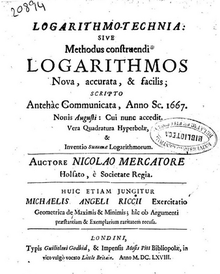
Nicholas (Nikolaus) Mercator (c. 1620, Holstein – 1687, Versailles), also known by his German name Kauffmann, was a 17th-century mathematician.
He was born in Eutin, Schleswig-Holstein, Germany and educated at Rostock and Leyden after which he lived from 1642 to 1648 in the Netherlands. He lectured at the University of Copenhagen during 1648–1654 and lived in Paris from 1655 to 1657. He was mathematics tutor to Joscelyne Percy, son of the 10th Earl of Northumberland, at Petworth, Sussex (1657). He taught mathematics in London (1658–1682). On 3 May 1661 he observed a transit of Mercury with Christiaan Huygens and Thomas Streete from Long Acre, London.[1] On 14 November 1666 he was elected a Fellow of the Royal Society.[2] He designed a marine chronometer for Charles II.[3]
In 1682 Jean Colbert invited Mercator to assist in the design and construction of the fountains at the Palace of Versailles, so he relocated there, but a falling out with Colbert followed.[4]
Mathematically, he is most well known for his treatise Logarithmo-technia on logarithms, published in 1668. In this treatise he described the Mercator series:
Nicholas Mercator was the first person to use the term natural logarithm.[5]
To the field of music, Mercator contributed the first precise account of 53 equal temperament, which was of theoretical importance, but not widely practised.[6]
He died at Versailles in 1687.
YouTube Encyclopedic
-
1/3Views:9 20663515 595
-
The Great Mathematicians - Professor Robin Wilson and Dr Raymond Flood
-
Privateer and Mathematician: The Voyages of Edward Wright
-
From the Wonders of Creation to the Holy Land: The Maps of the African & Middle Eastern Division
Transcription
Works

- 1676: Institutionum astronomicarum, London (1685, Padua)
- Institutionum astronomicarum libri duo (in Latin). Pavia: Tipografia del Seminario. 1685.
- Kinkhuysen (1661) Algebra ofte Stelkonst, translated by N. Mercator, appears 1968 in Mathematical Papers of Isaac Newton II: 295–364 with Newton commentary 364–446.
- 1664: Hypothesis astronomica nova, London
- 1666: "Certain problems touching some points of navigation", Philosophical Transactions of the Royal Society 1: 215–18
- 1668: Logarithmo-technia from HathiTrust or Logarithmtechnia from Internet Archive
- Wallis (1668) Review of Logarithmotechnia, Philosophical Transactions of the Royal Society 3: 753–9, followed by "Some further Illustration" by N. Mercator, pp 759–64.
- 1670: "Some considerations … method of Cassini", Philosophical Transactions of the Royal Society 5: 1168–75.
References
- ^ "1904Obs....27..369L Page 369". articles.adsabs.harvard.edu. Bibcode:1904Obs....27..369L. Retrieved 2021-08-03.
- ^ "Search Results". catalogues.royalsociety.org. Retrieved 2021-08-03.
- ^ Thomas Birch (on chronometer) (1756) History of the Royal Society II : 110 to 114 and 187, and in Oldenburg to Leibnitz 18 December 1670
- ^ D. T. Whiteside Nicolaus Mercator at Encyclopedia.com
- ^ O'Connor, J. J.; Robertson, E. F. (September 2001). "The number e". The MacTutor History of Mathematics archive. Retrieved 2009-02-02.
- ^ Benjamin Wardhaugh (July 2010) A Plague of Ratios from Mathematics Association of America
- Euclid Speidell (1688) Logarithmotechnia: the making of numbers called logarithms at Google Books
- Francis Maseres & Charles Hutton (1791) Scriptores Logarithmici, link from Google Books.
- John Aubrey (1813) Letters and Lives of Eminent Men II: 450,1, 473
External links
- Some Contemporaries of Descartes, Fermat, Pascal, and Huygens: N. Mercator
- O'Connor, John J.; Robertson, Edmund F., "Nicholas Mercator", MacTutor History of Mathematics Archive, University of St Andrews

